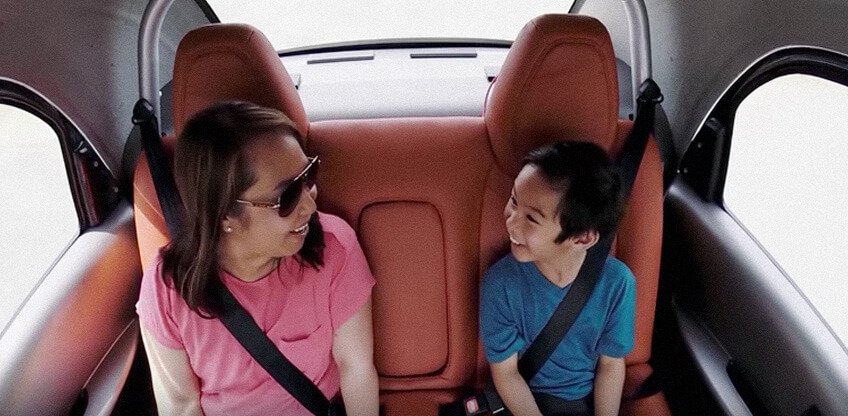Passengers
Waymo Is Designed for Passengers, Not Drivers
Members of the public in Phoenix have been in autonomous vehicles since 2016 through Waymo’s Trusted Testers Program. This pilot was developed to learn how people would use autonomous driving technology and integrate a hailable, fully autonomous vehicle into their daily lives.

For the last 100 years, vehicles have been designed with a human driver in mind. But over the last decade, Waymo has been designing autonomous driving technology with the passenger in mind.
Waymo has developed specific in-car features and user interfaces that help passengers understand what Waymo is doing on the road and let them:
- Set a destination
- Ask the vehicle to pull over
- Get in touch with Waymo support staff as needed
Waymo is also constantly refining how the car drives so that the ride is smooth and comfortable for passengers inside the vehicle.
Waymo’s Trained Drivers Onboard
Oftentimes, passengers will find Waymo-trained drivers in the cars. These trained drivers are onboard to make sure passengers have a great experience, and they serve as backup drivers only. The trained drivers are there to make sure this brand new traveling experience is as comfortable and convenient as possible.
Waymo-trained drivers undergo classroom and in-car training over several weeks and must pass manual and AV driving tests. The training curriculum covers, in part, education about the technology and how to safely monitor the vehicle on public roads. Test drivers also take a defensive driving course. The goal of this training is to equip test drivers with the skills needed to monitor the system and, if needed, to safely take control of the vehicle on public roads.
Waymo’s Technology Lets Passengers Stay Passengers
Waymo is building technology for passengers in its cars to stay passengers, which means it needs to create features that make the passenger experience comfortable and safe. The result is a user interface designed to help passengers understand what Waymo is doing on the road, provide an easy way for users to interact with the vehicle and get in touch with rider support.
Trained Specialists Are On Call
If at any time the passenger is looking for assistance, the passenger can press a button inside the Waymo vehicle’s second row or call and chat with our Rider Support team via our mobile app.
Rider Support Agents are trained to rapidly connect with passengers and initiate real-time voice communications to assist passengers in the vehicle. If the Rider Support Agents cannot connect through the car, they are trained to reach out to the passenger’s cellular phone. Passengers’ cellular phone numbers are stored in the Rider Support tool.
Waymo Can Detect If It Has Been in a Collision
While it is impossible to eliminate all accidents, Waymo is an autonomous driving technology company founded on finding a solution to reduce collisions and save lives. Waymo has built a system that can detect when one of its vehicles has been involved in a collision and immediately notify the Waymo operations center.
Waymo’s Team Knows How to Respond
Waymo’s trained specialists can initiate post-crash procedures, which include interacting with law enforcement and first responders, and sending members of its team on location. Rider Support Agents can also communicate directly with passengers through Waymo’s in-vehicle audio system.
Technicians Are Always Monitoring the Fleet
Before deploying its fully driverless vehicles, a Waymo technician ensures that each vehicle is ready for operation and puts the vehicle into driverless mode. Waymo has two separate teams that continuously monitor the fleet, when the vehicles are tested both with and without a human driver. Both teams monitor individual vehicle status around the clock and are notified of different situations.
Waymo’s Safety Status Can Be Checked Remotely at Any Time
At any point, each Fleet Response Specialist can check the operational status of any vehicle from their dashboard. The Fleet Response Specialists also receive notifications from each vehicle in their dashboard for specific situations that require attention, based on the thousands of checks that the vehicles run on their own systems every second, ranging from checking tire pressure to checking whether the vehicle has been involved in a collision.
Waymo Is Constantly Improving
When it comes to driving, experience is the best teacher.
From simulation to real-world driving on public roads, Waymo's extensive testing program underpins a rigorous and comprehensive feedback loop to ensure that every part of its cars are designed, tested, and iterated to be safe.
- Core Behavioral Competencies: Waymo performs testing to ensure that its system has the core driving skills to safely handle the complexity of real-world environments.
- Crash Avoidance: Waymo has also completed thousands of crash avoidance tests at our private test track, with a focus on some of the most common pre-crash scenarios.
- Backups and Redundancies: Waymo’s system performs thousands of “health checks” on itself every second and includes backups for the vehicle’s most important safety systems.
Waymo's technology takes care of all of the driving, allowing passengers to stay passengers.
